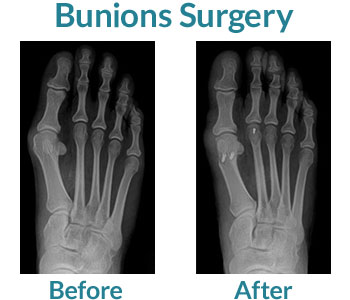
A bunion is often described as a bump on the side of the big toe. But a bunion is more than that. The visible bump actually reflects changes in the bony framework of the front part of the foot. The big toe leans toward the second toe, rather than pointing straight ahead. This throws the bones out of alignment—producing the bunion’s bump.
Causes
Bunions are most often caused by an inherited faulty mechanical structure of the foot. It is not the bunion itself that is inherited but certain foot types that make a person prone to developing a bunion.
Although wearing shoes that crowd the toes will not actually cause bunions, it sometimes makes the deformity get progressively worse. Symptoms may therefore appear sooner.
Symptoms
Symptoms, which occur at the site of the bunion, may include:
- Pain or soreness
- Inflammation and redness
- A burning sensation
- Possible numbness
Nonsurgical Treatment
In the early stages of bunions treatments are aimed at easing the pain of bunions, but they will not reverse the deformity itself. These treatments include:
- Changes in shoe wear
- Padding
- Activity modifications
- Medications
- Icing
- Injection therapy
- Orthotic devices
When Is Surgery Needed?
If nonsurgical treatments fail to relieve bunion pain and when the pain of a bunion interferes with daily activities, it is time to discuss surgical options with one of our foot and ankle surgeons.
Surgical bunion procedures are designed to remove the bump of bone, correct the changes in the bony structure of the foot and correct soft tissue changes that may also have occurred. The goal of surgery is the reduction of pain and deformity.
In selecting the procedure for your particular case, our foot and ankle surgeons will take into consideration the extent of your deformity based on the x-ray findings, your age, your activity level and other factors. The length of the recovery period will vary, depending on the procedure performed.
Our surgeons will evaluate your bunion deformity carefully and curate the best surgical plan for your condition. We take the best care of our patients during surgery and post-operatively to give you the best outcome possible.
What to Expect After Surgery
All surgery patients are sent home with post-op instructions. Following these post-op instructions will help minimize pain and swelling after surgery. Most patients feel discomfort for 3-5 days after surgery, while full recovery takes 6-8 weeks on average. In most bunionectomy cases, patients are able to walk with the use of a walker boot right after their procedure. And of course, patients can expect happy, painless feet.